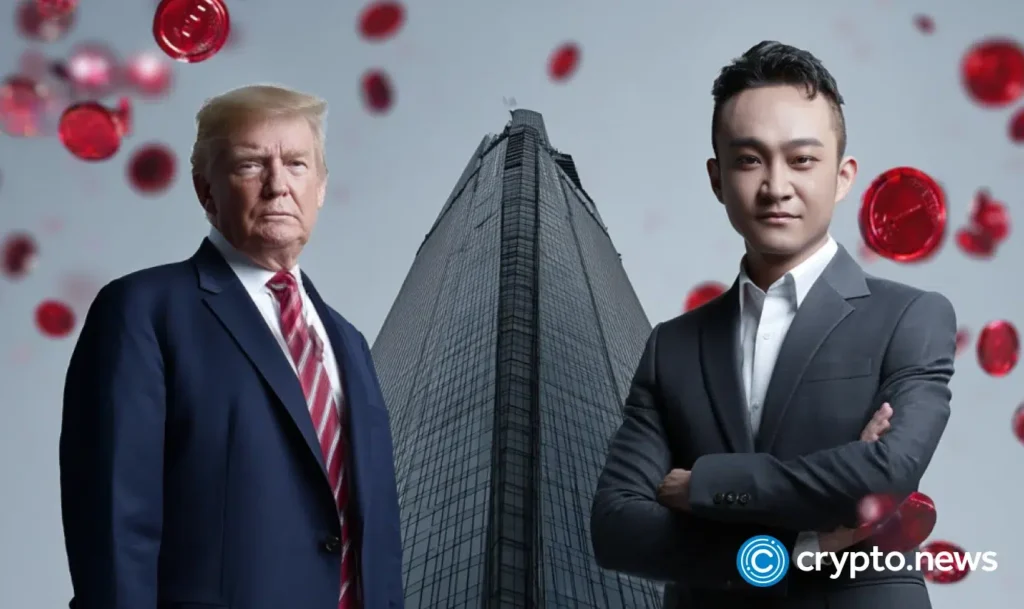The freeze of Justin Sun’s WLFI holdings has spotlighted governance concerns and ended his fragile bromance with Trump.
- WLFI froze Justin Sun’s wallets on Sep. 4, blocking access to 540 million unlocked and 2.4 billion locked tokens worth over $500 million.
- Sun denied manipulation, calling the freeze unreasonable, while blockchain firm Nansen traced WLFI’s sharpest sell-off to other flows, though its TRON ties raised questions.
- Sun has invested $75 million in WLFI since 2024, which was its largest external backer, and also held close political ties with Trump.
- Trump’s family controls 60% of WLFI’s parent company and retains 22.5 billion tokens, worth about $5 billion at launch, showing heavy insider concentration.
- Users remain divided, with some citing Sun’s history of manipulation and others calling the freeze hypocritical, leaving WLFI’s decentralization claims in doubt less than a week after launch.
Table of Contents
Sun’s stake frozen, WLFI’s decentralization tested
World Liberty Financial (WLFI), the Trump-linked token that entered the market only days ago, has already been pulled into a controversy that spotlights the fragility of its early alliance with Tron (TRX) founder Justin Sun.
WLFI administrators froze wallets tied to Sun on Sep. 4 after a transfer of 50 million WLFI tokens, worth about $9.2 million, triggered concern among traders.
The freeze went far beyond this single transfer. Contract-level permissions were used to blacklist Sun’s wallets, cutting off access to 540 million unlocked tokens and 2.4 billion locked tokens.
At WLFI’s current trading level of about $0.19, that amounts to roughly $102 million for the unlocked portion and close to $456 million for the locked balance. In total, more than half a billion dollars’ worth of Sun-linked WLFI has been immobilized.
The move comes on the heels of WLFI’s turbulent debut. The token climbed to $0.46 at launch on Sep. 1 before falling to lows near $0.16. As of Sep. 5, it is trading at about $0.19, which is 60% below its peak.
The freeze also exposed WLFI’s governance model. Instead of a community vote, the decision was imposed through administrative controls.
Sun was the largest holder of WLFI and had “bought the tokens fairly,” yet after transferring $9 million, “the team froze his funds because they didn’t like how he was operating,” one user said.
The user also added that “never before has a DeFi project taken such drastic action” and asked, “Why would anyone trust this team after that?”
Sun pushes back as data enters the spotlight
Sun was quick to distance himself from the market chaos. In his first response, he said the wallet in question had only carried out “a few general exchange deposit tests with very small amounts, followed by an address dispersion.”
He insisted that “no buying or selling was involved, so it could not possibly have any impact on the market.”
He followed up with a longer note to the WLFI community, calling the freeze “unreasonable” and reminding followers that he had been one of the earliest investors.
Sun argued that he had joined on equal terms, buying tokens “the same way” as others, and wrote that “tokens are sacred and inviolable — this should be the most basic value of any blockchain.”
He urged the team to unlock his holdings, framing fairness, transparency, and trust as the principles on which WLFI must be built if it wants long-term credibility.
Independent analysis from Nansen appeared to strengthen his defense. The firm traced WLFI’s sharpest drop, an 11.4% fall between 04:00 and 06:00 UTC on Sep. 4, to a different set of flows.
At 02:19 UTC, 40.8 million WLFI tokens were released from BitGo custody. Within minutes, they were routed through the market-making firm Flowdesk and deposited onto exchanges: 16.3 million to Bybit, another 16.3 million to wallets linked to OKX, and 8.2 million to Binance.
In less than 32 minutes, about 40 million tokens had hit trading venues, triggering a wave of sell orders that drove prices down from $0.21 to $0.18.
Sun’s 50 million WLFI transfer, worth $9.2 million, was logged later at 09:18 UTC. It was the third-largest transaction in the 48-hour period, but it came hours after the biggest sell-off. Nansen concluded the move followed the crash, not caused it.
The conclusion, though, did not end the debate. A user quickly mentioned that Nansen itself had recently joined the TRON blockchain as a “Super Representative,” a role that involves voting rights and block validation inside Sun’s own network.
In practice, this means Nansen is part of TRON’s governance structure, raising questions about whether it could objectively clear Sun of wrongdoing.
While the blockchain data remains visible and verifiable to anyone, the optics of an analytics provider with a financial and governance role in Sun’s ecosystem defending itself have kept doubts alive.
World Liberty Financial, meanwhile, has yet to release a statement explaining why Sun’s wallets were frozen in the first place.
A record of scrutiny and a seat at Trump’s table
Sun’s demand for fairness comes against a history of unresolved legal disputes and a project environment shaped by heavy insider control.
In March 2023, the U.S. Securities and Exchange Commission accused him and three of his companies of orchestrating more than 600,000 wash trades of TRX and BitTorrent (BTT) between 2018 and 2019. The regulator said these artificial trades inflated activity and helped generate about $31 million in profits.
The case also charged Sun with the unregistered sale of securities and alleged that celebrities such as Lindsay Lohan and Jake Paul promoted his tokens without disclosing payments.
Sun rejected the claims, arguing that the SEC was extending its jurisdiction too far since the tokens were sold outside the U.S.. In February 2025, the agency paused its action, citing public interest, but the matter remains unresolved.
At the same time, Sun has emerged as one of the largest backers of World Liberty Financial. He initially invested $30 million in 2024, and by mid-2025, his total stake had grown to at least $75 million.
On the eve of WLFI’s launch, that position was valued at $700 million, much of it still locked under vesting terms.
His role went beyond capital, as he was also listed as an advisor, putting him in the unusual position of being both WLFI’s largest external stakeholder and a figure under active regulatory cloud.
His connection to Trump’s crypto orbit extended beyond WLFI. In May 2025, Sun was among the top buyers of the Trump-themed meme coin, Official Trump (TRUMP), and secured an invitation to a private dinner with the president at his Virginia golf club.
Reports show that about 220 holders attended, having collectively spent nearly $148 million on the token. Sun ranked near the top of the list, reportedly committing more than $40 million, and received a $100,000 Trump-branded watch during the evening.
The dinner was framed as both a fundraiser and a celebration of Trump’s growing crypto influence, placing Sun squarely in the circle of high-value supporters.
Meanwhile, WLFI itself was structured around concentrated ownership from the start. The project raised $550 million in token sales, with more than 70% of that sum coming from high-net-worth buyers contributing $1 million or more each.
The Trump family, through its own entity, took 60% ownership of the parent company and secured 75% of the revenue rights from token sales.
In total, the family retained about 22.5 billion WLFI tokens, equal to 22.5% of the supply, which at launch values translated into approximately $5 billion on paper.
Another major investor, the Aqua 1 Foundation, linked to the United Arab Emirates, quietly acquired $100 million worth of WLFI in mid-2025.
The details of this purchase have not been fully disclosed, raising questions about foreign involvement in what is formally branded as a decentralized project, and the freeze of Sun’s wallets has only made that structure more questionable.
Users split as trust in WLFI falters
The incident has become a test of trust in WLFI, with users debating whether the decision was an act of protection or a sign that the project’s claims of decentralization cannot be taken at face value.
A user argued that Sun’s track record left little room for sympathy. He insisted that “every time Sun says he won’t sell, on-chain data must be checked,” pointing to past accusations of inflated volumes and abrupt exits.
That same tweet suggested the freeze “stops Sun, at least temporarily, from using WLFI to repeat the same pattern of launching a token, pumping it with artificial volume, and dumping on retail.”
Others took aim at the Trump family, calling the move hypocritical. A user noted that “the same people who cried for years because banks didn’t want to work with them just ended up freezing someone’s funds.”
The user added that WLFI fell 20% in the aftermath and that nearly a third of holders exited within days, framing the episode as a contradiction between the project’s branding and its actions.
One user joked that Sun had effectively been “rugged by the president of the United States.”
Meanwhile, another observed that “two months ago they were besties, today his one hundred million dollar wallet is frozen and the token price is tanking.”
With the team yet to explain its decision, the debate remains unresolved, and less than a week after launch, WLFI is already shaped as much by doubt as by ambition.



